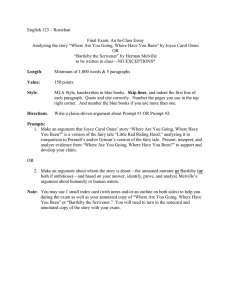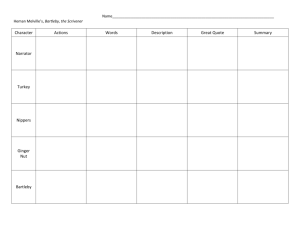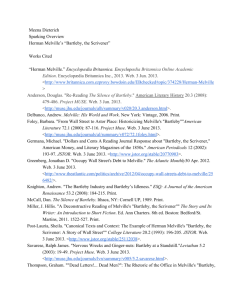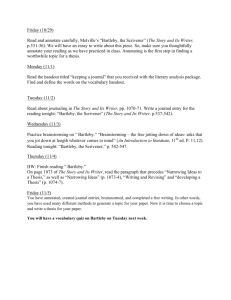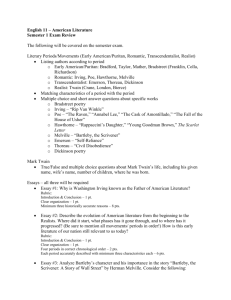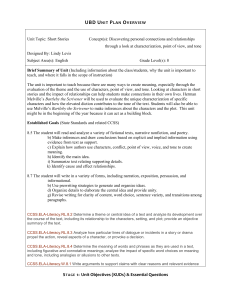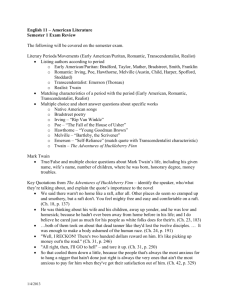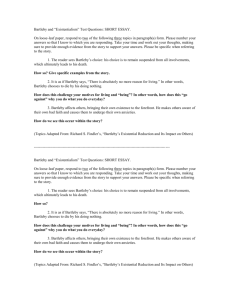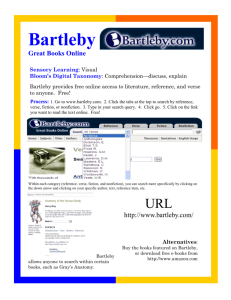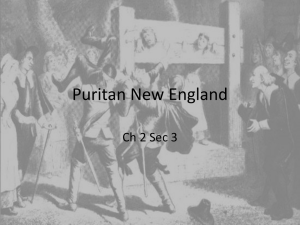Quiz 1
advertisement
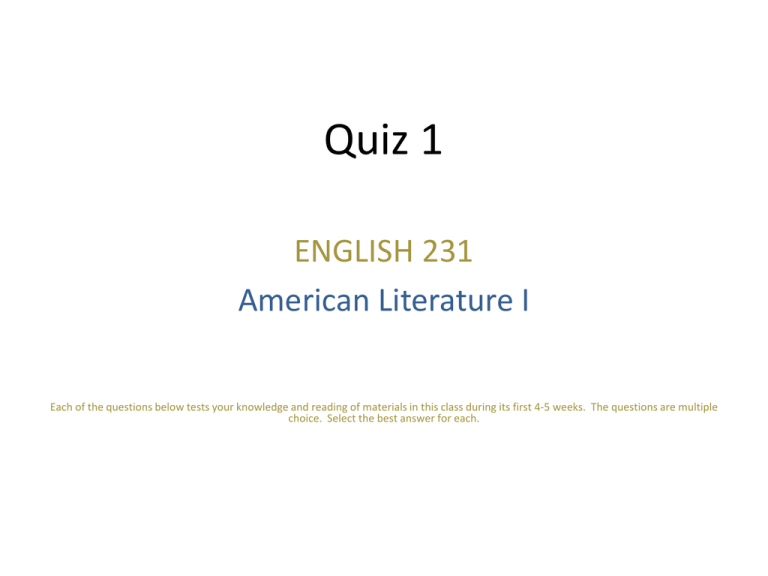
Quiz 1 ENGLISH 231 American Literature I Each of the questions below tests your knowledge and reading of materials in this class during its first 4-5 weeks. The questions are multiple choice. Select the best answer for each. 1. “An epic has four stages: the quest, ______, seeming defeat, and ultimate victory.” The missing stage in the sentence above is a. the rest b. the task c. the battle d. the test 2. Folklore and literature tends to fall into three general categories: Culture and Heritage; Society and Place; and… a. Drinking and Fornicating b. Lineage and History c. Mortals and Gods d. Redemption and Apotheosis 3. Many Native American folktales have an etiological function. In the strictest sense of the word, “etiological” means the story educates listeners a. about the causes of natural phenomena (the equivalent of today’s life sciences and physical sciences) b. the people’s ancestral origins (the equivalent of today’s study of cultural anthropology) c. how to tell a story (the equivalent of today’s communication sciences) d. how to be a good hunter (the equivalent of today’s technical training courses) 4. “Wohpe and the Gift of the Pipe” is best characterized as a. a Cherokee origins story (i.e., creation tale) about the sun’s smoldering embers b. an Iroqouis story about a trickster boy who tried to trade a blanket made of smoke c. a Lakota narrative about origin of certain community traditions and the sending up of prayers d. a Hupa tale about the importance of the White Deerskin Dance and the Peace Pipe Dance 5. Paul Tillich proposed the idea that human civilization, including its expressions of culture and literature, is driven by fear of a. living b. dying c. nonbeing d. mortality 6. Fill in the blank: Paul Tillich categorized humanity’s driving fear into three types of anxiety: ontological, __________, and moral. a. casual b. psychological c. cosmographical d. spiritual 7. Ontological anxiety can be best characterized as a. an intense worry about what, if anything, awaits us after death b. a concern about how we will be judged by others when we are no longer c. agitation about why we are born and who we really are d. an unresolved hope that our ego survives us 8. Abraham Maslow’s “Hierarchy of Needs” poses seven levels of need that motivate the actions of human beings in any society. Which of the following offers the best motivation for contemporary literature and art? a. The need to belong, establishing shared values and social attributes b. The need to self-actualize, including the pursuit of individuality and meaning c. The need to reconnect, both, with humanity and with the natural world d. The need for speed, exercising a right to overtake slow motorists in the left lane 9. Herman Melville’s “Bartleby the Scrivener: A Story of Wall Street” was published a. 1753 b. 1803 c. 1853 d. 1903 10. Melville’s story is narrated by a. a taciturn lackey named Bartleby by Melville b. a Wall Street lawyer unnamed by Melville c. a Wall Street lawyer named Oberlus by Melville d. a short-tempered white collar employee nicknamed “Turkey” by Bartleby 10. What does a typical “scrivener” do? a. They perform light custodial work, mostly involving a screwdriver. b. They’re go-fer’s: they sharpen pencils and perform odd jobs. c. They’re transcribers and copyists: they reproduce legal documents. d. Nothing. They prefer to do absolutely nothing. 11. Which of the following themes best characterizes Melville’s story? a. passive resistance: the individual vs. society b. the dehumanizing effect of society: loss of identity and meaning c. isolation and alienation: the walls created for us and by us d. all of the above 12. At the end of “Bartleby the Scrivener: A Story of Wall Street” … a. Bartleby dies; the narrator bemoans the state of humanity (Ah, humanity!) b. Bartleby is remanded into the custody of the narrator, then dies in his arms (“Ah, Bartleby!”) c. The narrator’s break from reality is complete, and he becomes Bartleby (“Ah, life!”) d. The narrator finds a new respect for life and finds himself (“Ah, Macarena!”) 13. The era of Colonial Puritanism is approximately a. 1525 to 1600 b. 1630 to 1700 c. 1700 to 1776 d. 1750 to 1850 14. The four main tenets of Puritan ideology are a. Original Disparity, Limited Arraignment, Irrepressible Grace, and Pre-indoctrination b. Ordinary Depravity, Unlimited Atonement, Erasable Grace, and Predisposition c. Depravity, Limited Grace, Irresistible Atonement, and Original Predestination d. Original Depravity, Limited Atonement, Irresistible Grace, and Predestination 16. Which of the following best explains the Colonial Puritan’s “Covenant Theology”? a. It was a “contract” between God and the Puritan people that assured them, as long as they behaved like they deserved to be among the Elect, God would hold up His end of the bargain. b. It was a promise that faithful Puritans would become the exemplary “City On the Hill” as long as they behaved like good people, worked hard, and helped one another. c. It helped Puritans cope with the paradox of limited atonement and predestination: you couldn’t know for sure if you were predestined to be “saved,” but you could act like you weren’t a sinner, because you knew only the least sinful people were among God’s “Elect.” d. All of the above. 17. Which of the following best describes the theological principles respected by good Colonial Puritans? a. Charity, faith, and a hopeful attitude b. Mindfulness, suffering, and self-deprivation c. Self-discipline, asceticism, and a responsible work ethic d. All of the above 18. Which of the following best describes the spiritual values held dearest by Colonial Puritans? a. the literal authority of the Bible and the importance of prosperity and success b. an epoch of peace and prosperity lasting 10,000 years c. the pragmatic belief that all things and events should be appreciated for their literal value d. None of the above 19. Which of the answers below most truthfully completes the following: “Puritans immigrated to North America in order to …” a. worship without fear of persecution and death b. escape retaliation for their attempts to undermine the Church of England and English society c. elevate their status from ‘cult’ to ‘organized religious institution’ d. convert the savages and assure them a place in the Kingdom of Heaven 20. Which of the following best defines Colonial Puritanism: a. conservative, fundamentalist and militant b. rebellious, inclusive, and revolutionary c. insincere, calculated, duplicitous d. devout, passive, tolerant
